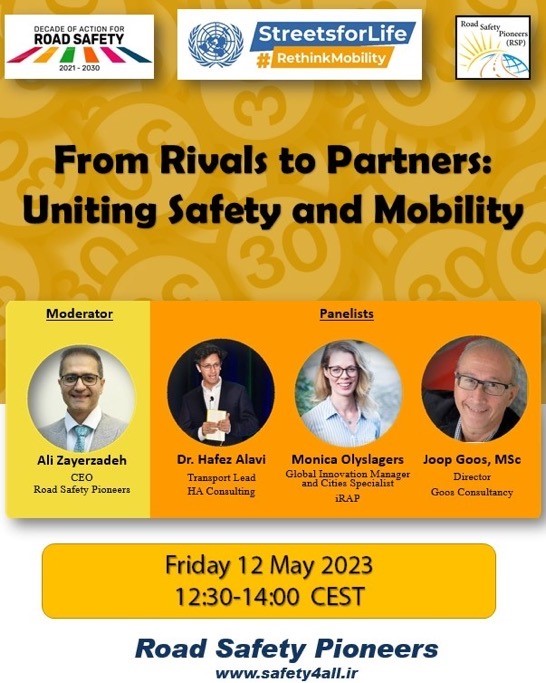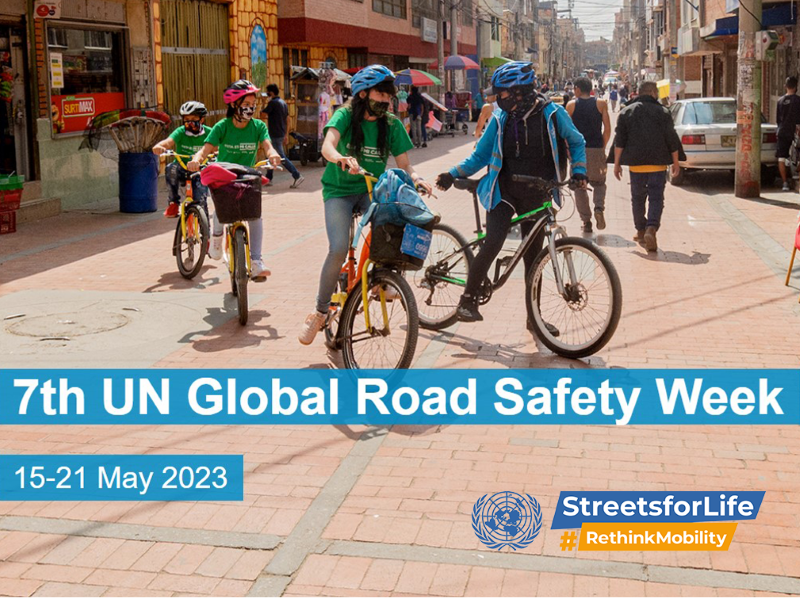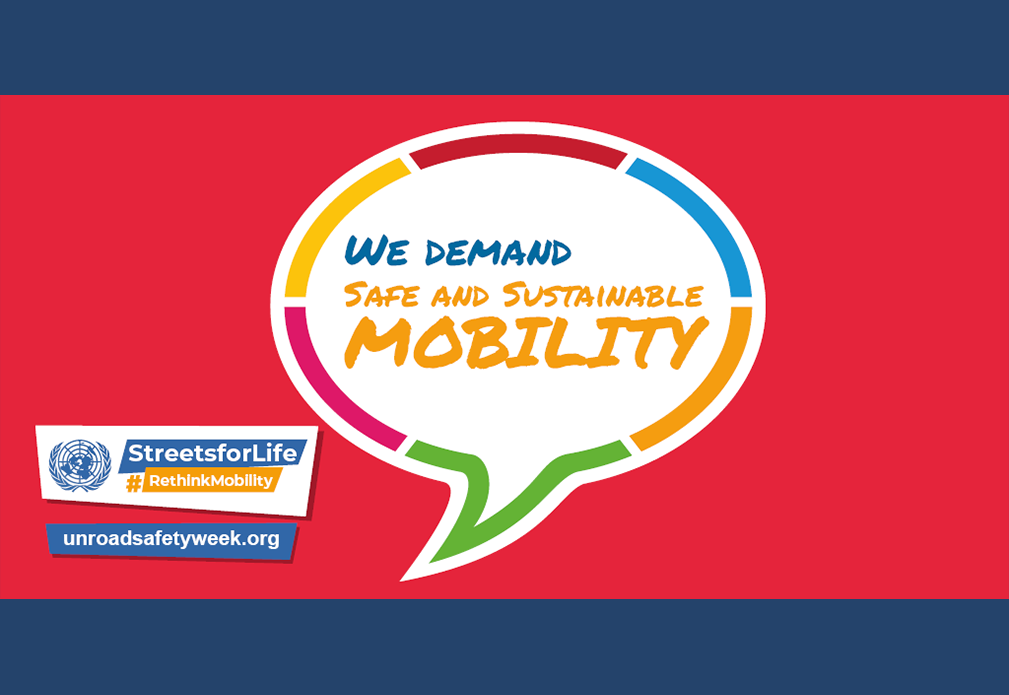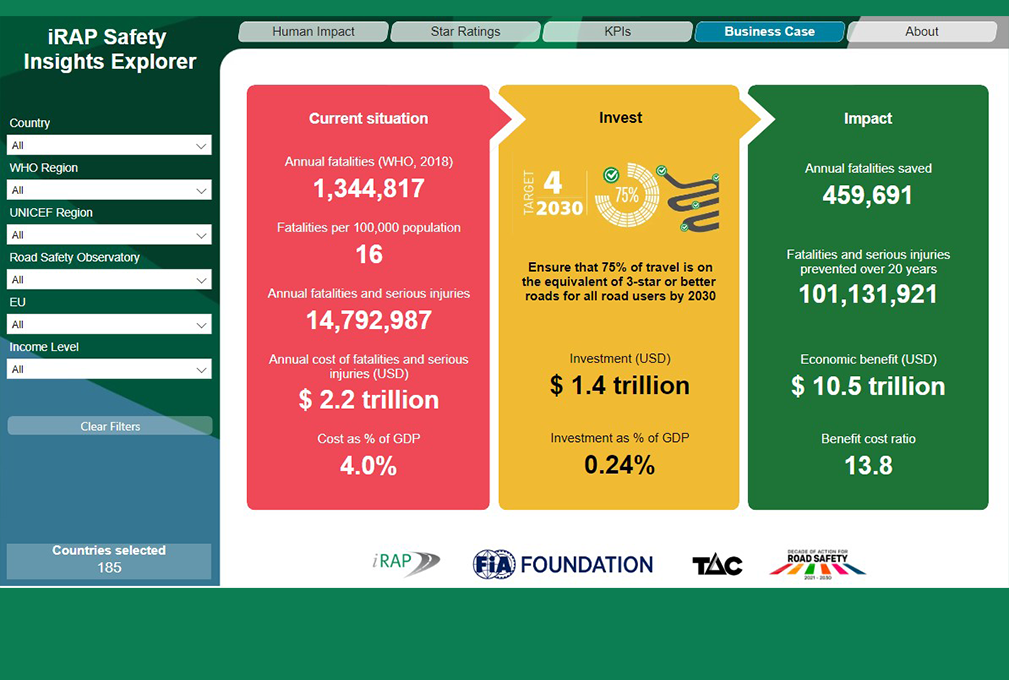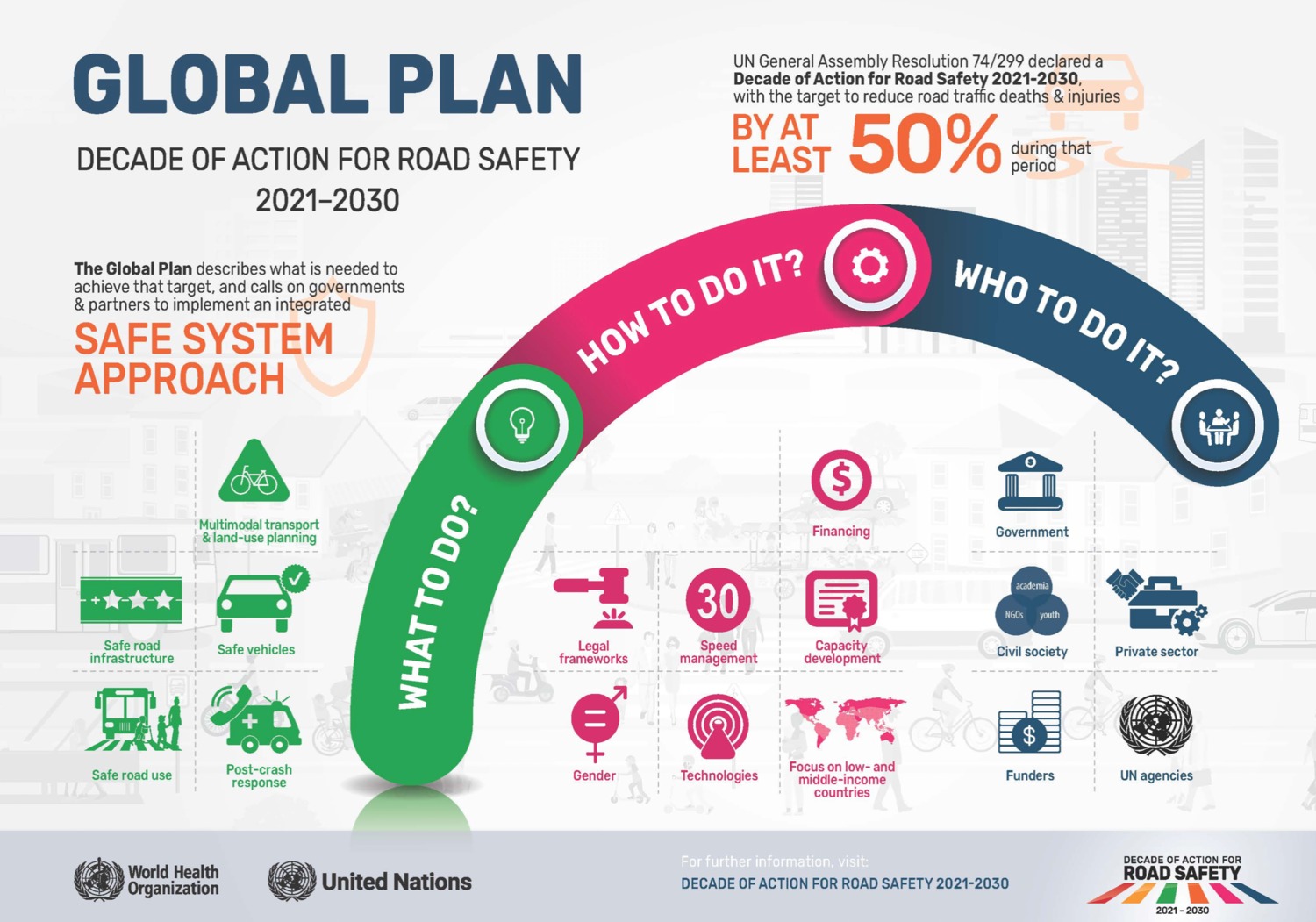iRAP calls on our partners and the community to support this year’s 7th UN Global Road Safety Week from 15-21 May with the theme #RethinkMobility.
Road traffic injures are a leading cause of death and disability worldwide, with around 1.3 million people killed and as many as 50 million people injured each year. For people aged 5-29 years, there is no greater threat to their lives. Globally, 1 of every 4 deaths occur among pedestrians and cyclists.
The Global Plan for the Decade of Action for Road Safety 2021-2030 reflects an ambitious target to reduce road traffic deaths and injuries by 50% by 2030. It highlights that they can be prevented by addressing the whole of the transport system, taking action to ensure safe roads, vehicles and behaviours as well as to improve emergency care.
The World Health Organisation, in collaboration with global partners, is organising this 7th UN Global Road Safety Week (UNGRSW) focussed on sustainable transport and, in particular, the need to shift to walking, cycling and using public transport. Road safety is both a prerequisite for and an outcome of this shift. Safer roads that put vulnerable road users at the heart of design are mandatory.
We encourage our partners to mark this year’s week by organizing events and activities and sharing messages and materials on social media that celebrate and call for safer roads with the hashtags:
#RethinkMobility #StreetsforLife #RoadSafety
Campaign key messages and iRAP tools, training, support and partnerships for UNGRSW and safer roads
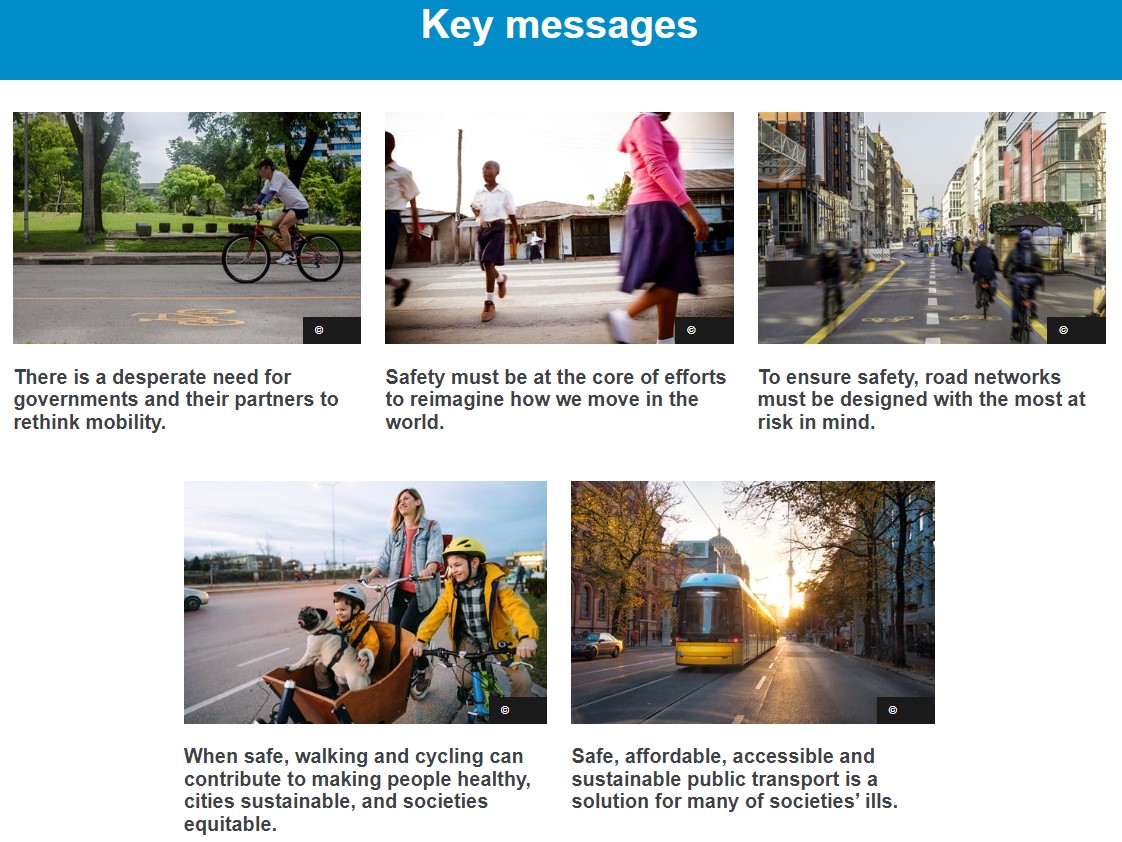
- There is a desperate need for governments and their partners to rethink mobility
Across the world, countries are including 3-star or better targets for safe road infrastructure in their National Road Safety Strategies and Action Plans. The targets provide clear and measurable key performance indicators, supported by globally recognised iRAP tools, training and support, for all partners to strive for and achieve. The strategies have the potential impact to eliminate high-risk roads in every country on earth! Be inspired and ensure your next strategy and action plan includes targets aligned to UN Targets 3 and 4 – to ensure all new roads are built to a 3-star or better standard for all road users (Target 3), and more than 75% of travel is on the equivalent of 3-star or better roads for all road users by 2030 (Target 4).
- Safety must be at the core of efforts to reimagine how we move in the world.
iRAP’s Safety Insights Explorer is a free and vital evidence-based tool to help road safety stakeholders understand the true extent of road trauma, the safety of the world’s roads, and the positive impact that can be made with targeted investment. Based on 500,000km of iRAP assessment data in 84 countries, it includes iRAP Star Rating and key performance metrics, new estimates of the types of road crash injuries that occur in each country that can be split by age group and sex, and regional filters, including for UNICEF regions and Road Safety Observatory regions.
The Road Safety Toolkit provides free information on the causes and prevention of road crashes that result in death and injury. It builds on decades of research to help policy makers, planners, engineers and practioners develop safety plans for car occupants, motorcyclists, pedestrians, bicyclists, heavy vehicle occupants and public transport users.
Together, iRAP and its partners have influenced the safety of over US$95 billion of infrastructure investment, Star Rated over 1.4 million kilometres of roads and designs, as well as road locations around 1,028 schools, mapped crash risk across 1.7 million kilometres of roads, and trained nearly 60,000 people globally. Working together, we’re making sure safety is understood and built into the roads we’re moving on in the world.
- To ensure safety, road networks must be designed with the most at risk in mind.
Despite knowledge and free tools to improve the safety of road designs, unsafe 1- and 2-star roads are still being built. Star Rating for Designs (SR4D) is a process and evidence-based programme of applications informed by the iRAP Methodology which enable the objective measure, and improvement, of the level of road safety ‘built in’ to a road design for vehicle occupants, motorcyclists, pedestrians and cyclists, before the commencement of civil works. It enables road engineers and designers, municipalities and road authorities, funding agencies and governments to make roads safer. Ensuring the safety of a road design before it clears the design phase directly equates to lives and serious injuries saved on the street.
- When safe, walking and cycling can contribute to making people healthy, cities sustainable, and societies equitable.
Based on investment plan analysis from 27 recent iRAP projects across 17 countries, every USD$200 spent on (off-road) segregated bike lanes saves an estimated 3.2 deaths and serious injuries per km and $385 – a benefit of nearly $2 for every $1 spent. (Source: iRAP)
Star Rating for Schools (SR4S) and CycleRAP are just two programmes iRAP and its partners are implementing across the world to improve the safety of journeys for pedestrians and bicyclists.
In October this year, iRAP’s Innovation Workshop, with the theme “Safer Roads for People and Planet”, will bring global partners together to explore innovations in road agency leadership, data, investment planning and finance that can be used to implement change and deliver on the Global Plan for the Decade of Action for Road Safety 2021-2030 and the Paris Agreement. It is being held from 5-6 October in Prague in association with the XXVIIth World Road Congress organised by PIARC (World Road Association).
- Safe, affordable, accessible and sustainable public transport is a solution for many of societies’ ills.
Public transit passengers have far lower traffic casualty rates than vehicle occupants, motorcyclists, bicyclists and pedestrians.
Compared with automobile travel, intercity and commuter passengers have about one-20th, urban rail passengers about one-30th, and bus passengers about one-60th the fatality rate per 100 million passenger-miles (Source: Victoria Transport Policy Institute).
When planning and designing safe cities, the safety of the entire journey from door-to-door must be considered. Public mass transit modes not only transport greater numbers en masse, they also offer 5-star safety. iRAP’s methodology and tools support the safety assessment of journeys from door-to-door for all road users and inform safer road investment plans to save lives and reduce injuries.
Let’s work together to #RethinkMobility and get behind this year’s UN Global Road Safety Week campaign!
Remember to tag iRAP as well as #RethinkMobility #StreetsforLife and #RoadSafety.
Free assets to support your UNGRSW campaign activity
Explore the iRAP Safety Insights Explorer for valuable data to inform your advocacy. Simply filter, create an image snip and post sourcing irap.org/safety-insights-explorer/
We must #RethinkMobility in terms of multimodal journeys
iRAP Safety Insights Explorer provides data to inform our decisions to #RethinkMobility
In collaboration with the Global Designing Cities Initiative (GDCI), we are re-releasing 3 animations from UNGRSW 2021 to promote how we can #RethinkMobility with lower speed streets to protect people and enable healthy, more sustainable choices such as walking and cycling. Thanks to GDCI and Vision Zero Sergek for collaborating with us to create the animations.
Just some of our activities for the week
